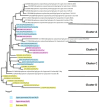Wildlife-Livestock Host Community Maintains Simultaneous Epidemiologic Cycles of Mycoplasma conjunctivae in a Mountain Ecosystem
- PMID: 38787189
- PMCID: PMC11125856
- DOI: 10.3390/vetsci11050217
Wildlife-Livestock Host Community Maintains Simultaneous Epidemiologic Cycles of Mycoplasma conjunctivae in a Mountain Ecosystem
Abstract
Infectious keratoconjunctivitis (IKC) is an eye disease caused by Mycoplasma conjunctivae that affects domestic and wild caprines, including Iberian ibex (Capra pyrenaica), a medium-sized mountain ungulate. However, its role in IKC dynamics in multi-host communities has been poorly studied. This study assessed M. conjunctivae in Iberian ibex and seasonally sympatric domestic small ruminants in the Natural Space of Sierra Nevada (NSSN), a mountain habitat in southern Spain. From 2015 to 2017, eye swabs were collected from 147 ibexes (46 subadults, 101 adults) and 169 adult domestic small ruminants (101 sheep, 68 goats). Mycoplasma conjunctivae was investigated through real-time qPCR and statistically assessed according to species, sex, age category, year, period, and area. The lppS gene of M. conjunctivae was sequenced and phylogenetically analysed. Mycoplasma conjunctivae was endemic and asymptomatic in the host community of the NSSN. Three genetic clusters were shared by ibex and livestock, and one was identified only in sheep, although each host species could maintain the infection independently. Naïve subadults maintained endemic infection in Iberian ibex, with an epizootic outbreak in 2017 when the infection spread to adults. Wild ungulates are epidemiologically key in maintaining and spreading IKC and other shared diseases among spatially segregated livestock flocks.
Keywords: Capra pyrenaica; Iberian ibex; PCR; endemic; epidemiology; infectious keratoconjunctivitis; reservoir.
Conflict of interest statement
The authors declare no conflicts of interest. The funders had no role in the design of the study; in the collection, analyses, or interpretation of data; in the writing of the manuscript; or in the decision to publish the results.
Figures



Similar articles
-
Mycoplasma conjunctivae in domestic small ruminants from high mountain habitats in Northern Spain.BMC Vet Res. 2013 Dec 13;9:253. doi: 10.1186/1746-6148-9-253. BMC Vet Res. 2013. PMID: 24330682 Free PMC article.
-
Postepizootic Persistence of Asymptomatic Mycoplasma conjunctivae Infection in Iberian Ibex.Appl Environ Microbiol. 2017 Jul 17;83(15):e00690-17. doi: 10.1128/AEM.00690-17. Print 2017 Aug 1. Appl Environ Microbiol. 2017. PMID: 28526790 Free PMC article.
-
Infectious keratoconjunctivitis in wild Caprinae: merging field observations and molecular analyses sheds light on factors shaping outbreak dynamics.BMC Vet Res. 2017 Mar 4;13(1):67. doi: 10.1186/s12917-017-0972-0. BMC Vet Res. 2017. PMID: 28259139 Free PMC article.
-
Infectious keratoconjunctivitis of ibex, chamois and other Caprinae.Rev Sci Tech. 2002 Aug;21(2):335-45. doi: 10.20506/rst.21.2.1338. Rev Sci Tech. 2002. PMID: 11974619 Review.
-
Diseases of Iberian ibex (Capra pyrenaica).Eur J Wildl Res. 2023;69(3):63. doi: 10.1007/s10344-023-01684-0. Epub 2023 Jun 1. Eur J Wildl Res. 2023. PMID: 37274486 Free PMC article. Review.
References
-
- Holzwarth N., Pospischil A., Marreros N., Ryser-Degiorgis M.P., Mavrot F., Frey J., Thoma R., Borel N. Alpine ibex (Capra i. ibex) is not a reservoir for chlamydial infections of domestic ruminants and humans. Eur. J. Wildl. Res. 2011;57:233–240. doi: 10.1007/s10344-010-0416-7. - DOI
Grants and funding
LinkOut - more resources
Full Text Sources

